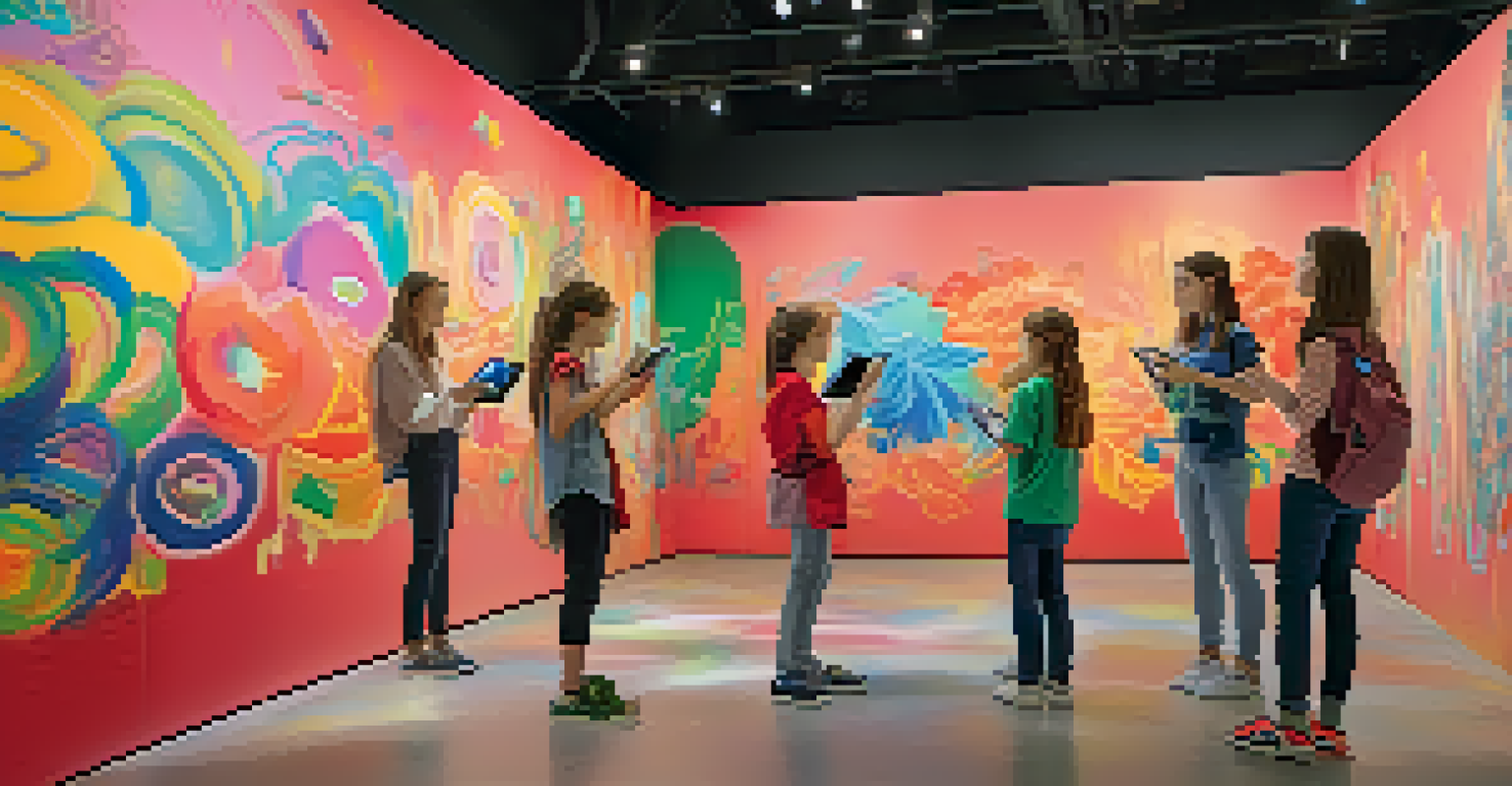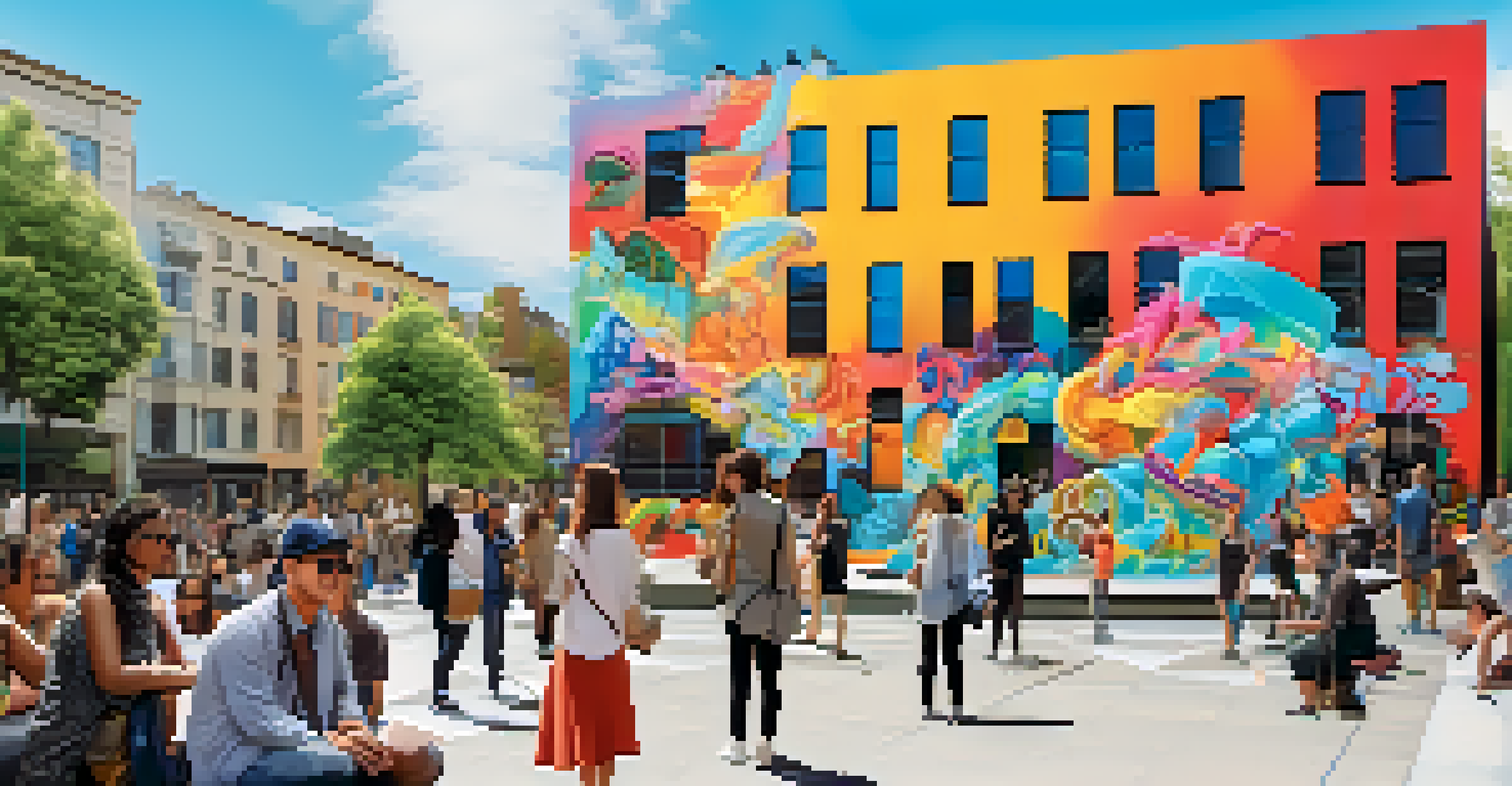Augmented Reality: Bridging the Gap Between Art and Viewer

Understanding Augmented Reality in the Art World
Augmented Reality (AR) is a technology that overlays digital content onto the real world, enhancing our perception of reality. In the art world, this means that viewers can experience artworks in a completely new way. For instance, a simple painting can come to life with animations or additional information that enriches the viewer's understanding of the piece.
Art is not what you see, but what you make others see.
This blend of digital and physical experiences creates a more interactive encounter with art. Imagine standing in front of a classic painting and using your smartphone to see it transform, revealing the artist's techniques or historical context. This is where AR shines, bridging the gap between traditional art and modern technology.
As artists experiment with AR, they have the opportunity to reach a broader audience. People who may not feel connected to traditional art can engage with it in a familiar digital format, making art accessible to everyone. This democratization of art is one of the most exciting aspects of AR technology.
How AR Enhances Art Appreciation
AR can significantly deepen the viewer's appreciation of art by providing context that might otherwise be overlooked. For example, using AR, viewers can learn about an artwork's background, the artist's inspirations, or the cultural significance of a piece. This extra layer of information can transform a simple viewing into an immersive learning experience.

Imagine visiting an art gallery and scanning a sculpture with your phone. Suddenly, you see a video of the artist discussing their vision for the piece, or you might even witness how it was created in real-time. This interactive approach fosters a connection that traditional gallery settings often lack.
AR Transforms Art Engagement
Augmented Reality enhances viewer interaction by providing immersive experiences and additional context to artworks.
By engaging multiple senses—sight, sound, and sometimes even touch—AR can evoke stronger emotional responses. It encourages viewers to think critically about what they see, moving beyond surface-level appreciation to a more profound connection with the art.
The Role of Technology in Art Creation
Artists are now embracing technology in innovative ways, creating artworks specifically designed for AR experiences. This shift allows for a new kind of storytelling that combines visual art with digital narratives. Artists can layer their work with interactive components, offering a fresh perspective on their creative process.
Technology is best when it brings people together.
For example, a mural might include an AR component that reveals hidden elements when viewed through an app. This approach not only enhances the artwork but also engages the audience in a playful exploration. It's like a treasure hunt, where viewers discover new facets of the art piece as they interact with it.
As technology continues to evolve, so too do the possibilities for artists. The fusion of traditional techniques with digital tools pushes the boundaries of creativity, encouraging artists to think outside the box and invent new forms of expression.
AR in Museums and Galleries: A New Era
Many museums and galleries are adopting AR technology to enhance visitor experiences. By integrating AR into exhibitions, institutions can offer interactive tours that guide visitors through the art in engaging ways. This not only attracts tech-savvy audiences but also revitalizes interest in traditional art forms.
For instance, the Louvre has experimented with AR apps that allow visitors to see additional layers of information about the art on display. This means that rather than relying solely on placards, visitors can interact with the artwork through their devices, making the experience more personalized and informative.
Technology Redefines Art Creation
Artists are increasingly using AR to create innovative works that blend traditional techniques with digital storytelling.
Such initiatives help museums cater to different learning styles, appealing to both visual and auditory learners. By providing various modes of engagement, museums can foster a deeper connection between art and its audience, encouraging repeat visits and ongoing interest.
Engaging a New Generation of Art Lovers
One of the most exciting aspects of AR in art is its ability to engage younger audiences. Today's youth are digital natives, often seeking experiences that blend technology with their interests. By incorporating AR, artists and institutions can capture the attention of a generation that wants to interact with art in meaningful ways.
Consider a scenario where a school group visits an art exhibit equipped with AR devices. They can scan artworks to unlock games, quizzes, or augmented narratives that make learning about art fun and engaging. This not only sparks interest but also fosters a sense of community around art appreciation.
As more young people embrace AR in their everyday lives, it creates a culture where art becomes a dynamic conversation rather than a passive experience. This shift has the potential to cultivate lifelong art lovers who appreciate the depth and creativity that both art and technology offer.
Challenges and Considerations in AR Art
Despite its potential, the integration of AR in the art world is not without challenges. One major concern is the accessibility of technology for both artists and audiences. Not everyone has access to the necessary devices or the internet, which can create a divide in who can experience these innovative artworks.
Additionally, there are questions about the permanence of digital art in an ever-changing technological landscape. As software and hardware evolve, will older AR experiences still be accessible? Artists and institutions must consider how to preserve these experiences for future audiences.
AR Engages New Art Audiences
By incorporating AR, artists and institutions can attract younger, tech-savvy audiences who seek interactive art experiences.
Lastly, there's the question of how AR affects the authenticity of art. Some purists argue that the digital overlay can detract from the original artwork, while others see it as a new form of expression. This ongoing dialogue is crucial as the art world navigates the implications of merging technology with traditional practices.
The Future of Art with Augmented Reality
Looking ahead, the future of art with AR is brimming with possibilities. As technology advances, we can expect even more immersive and interactive experiences that challenge our perceptions of art. The boundaries between the physical and digital realms will continue to blur, leading to new forms of artistic expression.
Imagine visiting a city where public art installations come alive through AR, turning everyday streets into vibrant galleries. This could transform urban spaces, fostering community engagement and sparking conversations about art in public life. Such experiences would not only beautify our surroundings but also create a shared cultural dialogue.

As artists and technologists collaborate, the art world will likely see a wave of innovation that emphasizes inclusivity and accessibility. By embracing AR, we can look forward to a future where art is not just seen but experienced, making it a vital part of our everyday lives.